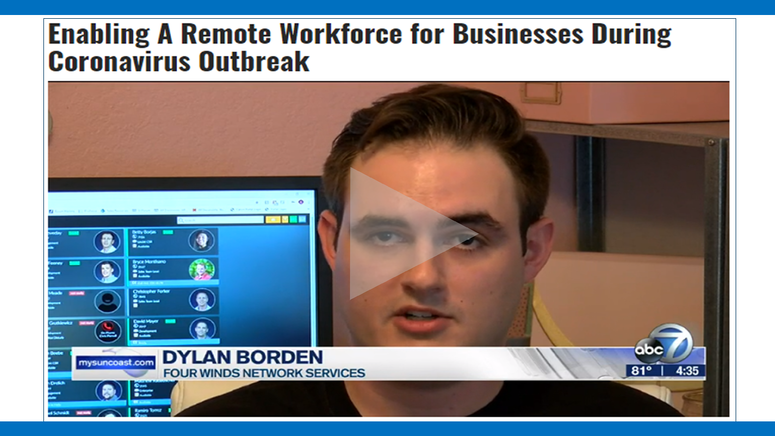Using Work Computers At Home
Many organizations have employees who work from home on company-supplied systems or devices
4 min read
Dylan Borden
:
May 31, 2023 9:50:53 AM

The Coronavirus outbreak has had a dramatic impact on businesses across the countries but remote work capabilities have allowed companies to maintain operations while keeping their teams safe. The benefits are obvious, while the country is in lockdown employees are able to connect and collaborate where ever they are, and the best part is once enabled companies can always take advantage of their remote network no matter the situation.
Now, creating a remote-enabled workforce sounds great but for companies new to the process, it’s often easier said than done. Establishing your system will take time and must be executed carefully in order to be successful and secure. With that being said, what do you have to do to create your very own remote workforce?
---------------------------------------------------------------------------------------------------------------------------
First things first, which positions are eligible to work remotely? Obviously, not every job can be done from the comfort of your home but you want to make a clear distinction about what positions are eligible and which are not. By analyzing your work and operating model you should be able to determine which jobs should be done out of the office. An example would be an inside sales rep, if all their work is conducted over the phone and email does it really matter where they are making the calls?
By establishing what positions can work from home right from the beginning you will eliminate many future requests or inquiries about remote work.
---------------------------------------------------------------------------------------------------------------------------
Once you’ve determined you want to allow for remote employees you need to start setting expectations, beginning with availability. If you run an east coast, 9 to 5 operation, do you expect your employees to log on during that same time frame, or are your employees able to set their own hours?
It’s important to create a schedule from the outset so there is no animosity between co-workers with set hours and those who can make their own.
---------------------------------------------------------------------------------------------------------------------------
Communication is key in building a successful remote workforce. When in an office, it’s easy enough to just pop over to a co-worker's desk if you need their assistance but how does that work when your employees are scattered?
This is why it is important to define what type of time frame remote workers are expected to respond to as well as what types of communication should be used. For instance, should someone be expected to reply to an email immediately, within the hour, same day? What about phone calls?
Establishing communication expectations will help foster a healthy relationship between your teams.
---------------------------------------------------------------------------------------------------------------------------
One of the biggest concerns over employees working from home is how productive they will be which is why you need to create a policy that specifies how their performance will be measured. There are a number of different ways you can do this from the number of accounts closed to or amount of client interactions, so you will need to sit down and really determine what metrics work best for your business.
A word of advice, if possible, try to measure business outcomes as opposed to metrics like the number of hours or calls. The point is, the number of calls, whether it be 100 or 10, is not as important as the desired outcome which could be something like the number of new qualified leads or closed sales.
---------------------------------------------------------------------------------------------------------------------------
This might sound obvious, but your employees won’t be successful working remotely without the right tools, and you should be very upfront about what you are willing to provide remote employees. Are your employees expected to provide their own computer? If so, what specs must their computer have to qualify?
Things like internet speed could also come into play as it can very much affect your ability to work efficiently. If it takes an hour to download a file on your home Wi-Fi network that’s really not going to cut it… So, let potential remote employees know-how equipment will be handled so they don’t feel they are taking on unjustified financial burdens.
---------------------------------------------------------------------------------------------------------------------------
Beyond equipment policy, it’s also important to specify what sort of technical support remote employees are offered. Most large companies offer technical support on-site, but not for remote employees.
When experiencing technical difficulties, are remote employees responsible for getting their own support or do you offer remote support or work with a third-party provider?
---------------------------------------------------------------------------------------------------------------------------
Security should be of the utmost importance when it comes to establishing your remote workforce. Large companies, especially those handling sensitive information typically run on secure networks with multiple levels of defense.
The same cannot be said for remote employees whose home network could be more vulnerable. When it comes to working on a public Wi-Fi network, employees must be particularly careful, and companies may want to request employees avoid them altogether.
Establishing private methods of communications, access to business-critical applications and the ability to safely share and exchange sensitive data are just a few factors to consider. Make sure your remote network has been professionally secured or you could be risking your business!
---------------------------------------------------------------------------------------------------------------------------
Client confidentiality is closely tied to security but should be clearly stated in your policy to ensure your employees aren’t putting clients in compromising situations.
For instance, if a client would like to arrange a video call to discuss sensitive documents you may want to make sure your employee doesn’t conduct the call from a crowded coffee shop! This may sound obvious, but by making it part of your policy you set the precedent and eliminate confusion.
---------------------------------------------------------------------------------------------------------------------------
One of the last things you want to consider is the physical environment your remote workers operate in. If you have a preference of the type of workspace you want to allow state this upfront so that employees know whether they will be expected to commute somewhere or need to establish some sort of home office.
Most offices are secure and offer employees a safe and healthy environment to work, so it would be wise to consider those factors when determining any workspace requirements.
---------------------------------------------------------------------------------------------------------------------------
Creating a remote workforce is no easy task and several factors need to be considered to successfully enable your team to work remotely, but, if executed properly, a business can stand to reap plenty of benefits. Not only does the business have the flexibility to operate under any circumstances and avoid costly downtime, but employees will also enjoy the freedoms of a modern workplace and an overall improved work environment.
If you need help establishing your remote workforce give us a call at 941-315-2380 or schedule a time to meet with one of our experts and make sure your business is ready to take on any situation!

Many organizations have employees who work from home on company-supplied systems or devices

As the Corona virus outbreak continues to make it's way across the US and the rest of the world, companies have turned to remote technology and it...

Raise your hand if you’ve ever been sitting at your desk frustrated because something is preventing you from getting your work done or...